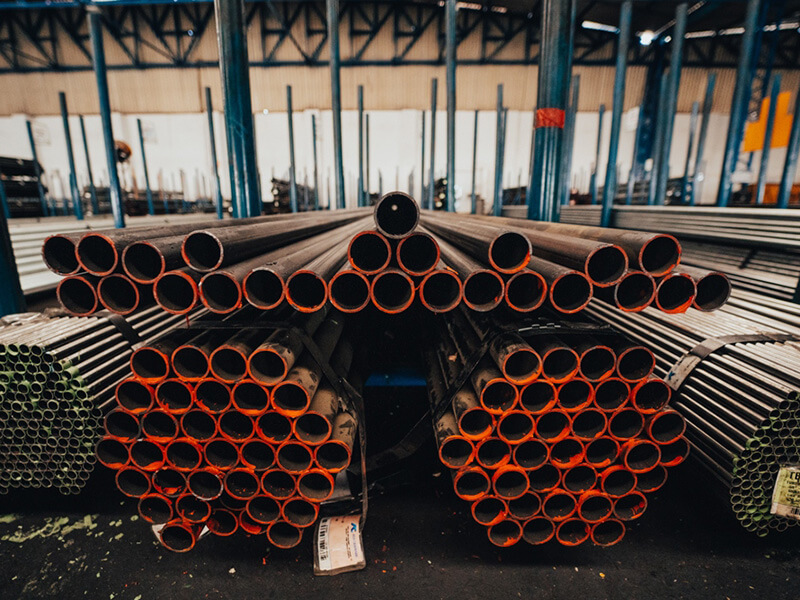
Carbon steel is widely used in a variety of sectors, from industry to household appliances. Therefore, it is one of the most popular metal alloys.
This composition results from the combination of elements that, depending on the percentage applied, can be used for a wide range of purposes.
In this text, we'll explore in detail the properties of carbon steel and its various uses. Stay tuned for more information and to understand where to use it appropriately!
To begin, let's understand what carbon steel is. It is a type of steel Composed primarily of iron and carbon, it is one of the most widely used materials in industry due to its mechanical properties, availability, and relatively low cost.
The amount of carbon present ranges from 0.03% to approximately 2.1% by weight. Carbon content directly influences the hardness, strength, and other mechanical properties of the material. That is, the higher the content, the harder the steel, but it can also make it more brittle.
In addition to carbon, it may contain other alloying elements in smaller quantities, such as manganese, silicon, and sulfur, which can affect its properties. These elements adjust the steel's characteristics to meet specific application requirements.
Among the main applications of carbon steel, we've listed the main ones below. Check it out!
Widely used in the construction of structures such as buildings, bridges, stadiums, and transmission towers. Its high strength and ability to withstand heavy loads make it ideal for this purpose.
It's also used in the manufacture of automobiles, trucks, and other vehicles. It's used in bodies, chassis, and components. structural and engine parts due to their strength, durability and ability to absorb impacts.
Carbon steel pipe can be used in the construction of oil and gas pipelines, as well as power generation equipment such as wind turbines and solar towers. The reason is simple: it can withstand high pressures and temperatures.
Carbon steel is also used in household applications, such as pans, cutlery, pressure cookers, and appliances. This is because it resists corrosion and has the ability to transfer heat evenly.
It can be used in a variety of industrial equipment, such as storage tanks, boilers, heat exchangers, piping, and agricultural machinery. It's a popular material for its strength, durability, and ease of fabrication.
Toys that require greater strength and durability, such as remote-controlled cars, bicycles, scooters, and toy cars, are also eligible. However, due to the material's potential rigidity, other materials may be more commonly used for this purpose.
Carbon steel can be used in gym equipment such as weight bars, dumbbells, and strength training machines. It's commonly used in the manufacture of bars and structures that need to support heavy loads.
In some hospital equipment, carbon steel can be used in structural parts or supports that require strength and rigidity. For example, stretchers, monitor stands, and transport carts require stability and durability.
However, in hospital environments, where hygiene and corrosion resistance are essential, other materials, such as stainless steel or plastic, are most commonly used.
Carbon steel offers a number of benefits that contribute to its widespread use in various industries. Some of these include:
Carbon steels are classified according to their chemical composition, mechanical properties and heat treatments that can be applied to them.
The most common classification of carbon steels is made according to the SAE/AISI standard (Society of Automotive Engineers/American Iron and Steel Institute) and the ASTM standard (American Society for Testing and Materials).
Products made from this material, such as carbon steel sheet, pipes, scraps and carbon steel bars, are quite popular.
Find reliable suppliers Buying or selling these materials can be a simpler task than you might think, as long as you know the right places to look.
At Grupo Aço Cearense, you can count on a variety of carbon steel products, such as sheets, bars, profiles, tubes, and rebar, to meet your project needs, in any sector.
As we said, steel is an alloy of iron and carbon, with the addition of other alloying elements in smaller quantities.
The main difference between carbon steel and general steel is the carbon content. Carbon steel contains a higher carbon content compared to other steel grades.
Another difference is the presence of alloying elements other than carbon in steel. When added, they improve properties such as corrosion resistance, wear resistance, mechanical properties, hardness, and so on.
Carbon steel is widely used in various industries due to its availability, versatility, and affordable cost. If you plan to use it in your projects, simply find the right supplier and check the technical specifications.
Now that you understand more about carbon steel and its applications, how about reading other content on the blog? Take the opportunity to check out our portfolio and request your quote from the Ceará Steel Group!